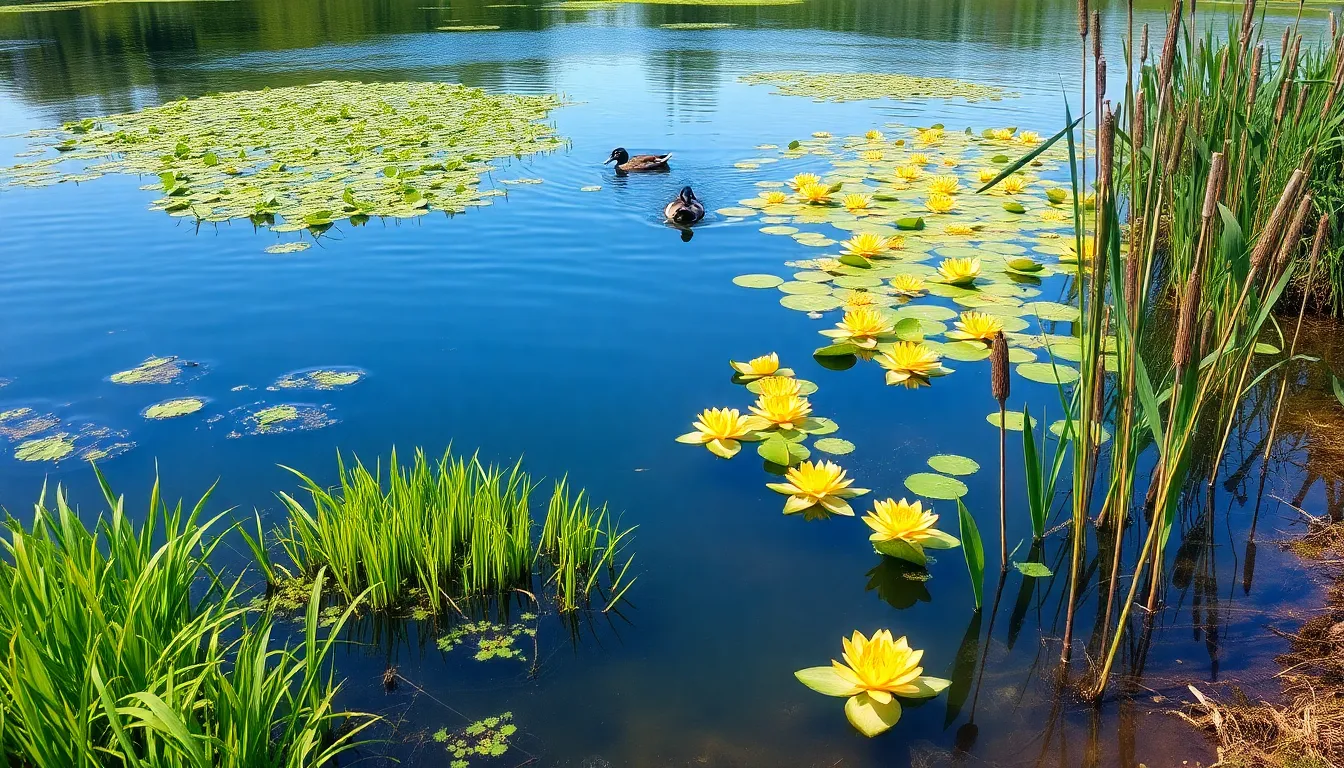The Best Fluffy Pancakes recipe you will fall in love with. Full of tips and tricks to help you make the best pancakes.

Aquatic Biome Plants: Nature’s Unsung Heroes for Healthy Ecosystems
Dive into the fascinating world of aquatic biome plants, where the greens are always lush and the waters are anything but boring! These remarkable plants not only add beauty to our lakes and rivers but also play a crucial role in maintaining the health of their ecosystems. Think of them as the unsung heroes of the water world, tirelessly working behind the scenes to keep everything balanced—like the friend who always reminds you to hydrate at parties.
Aquatic Biome Plants
Aquatic biome plants play a crucial role in the ecosystems of lakes and rivers. These plants provide habitat and shelter for various aquatic organisms, including fish, amphibians, and invertebrates. They contribute to water quality by absorbing nutrients and reducing excess pollutants.
Submerged plants, such as eelgrass and pondweeds, thrive underwater. They offer oxygen during photosynthesis and stabilize sediments, minimizing erosion. Floating plants, like water lilies and duckweed, provide shade and reduce evaporation, maintaining cooler water temperatures. Emergent plants, including cattails and bulrushes, grow at the water’s edge, supporting shoreline stability and filtering run-off.
Aquatic plants exhibit adaptations to their environments. For instance, some possess specialized air-filled tissues that facilitate buoyancy. Many also develop flexible stems that withstand water currents. Notably, the variety of textures and shapes in aquatic plants adds richness to their habitats.
In terms of biodiversity, aquatic biome plants enhance ecological interactions. They support interactions among organisms, from herbivores feeding on them to predators that rely on herbivores. Aquatic plants also serve as nursery habitats for juvenile fish, promoting survival rates.
Understanding these components emphasizes their vital role in sustaining aquatic ecosystems. Their presence signifies ecological health, making monitoring their populations essential. Conservation efforts often focus on protecting aquatic plants from invasive species and pollution.
The diversity of aquatic biome plants reflects the complexity of their ecosystems. By examining their characteristics and contributions, one gains insight into the intricate relationships within aquatic environments.
Types of Aquatic Biome Plants

Aquatic biome plants play a critical role in maintaining ecological balance. Their diversity falls into three main categories: submerged plants, emergent plants, and floating plants.
Submerged Plants
Submerged plants thrive completely underwater, providing essential habitats for aquatic life. They produce oxygen through photosynthesis, supporting fish and other organisms. Species like eelgrass and coontail often dominate these regions. Adaptations such as flexible stems allow these plants to withstand water currents while rooted in sediments.
Emergent Plants
Emergent plants grow partially above the water surface, anchoring themselves in aquatic environments. Cattails and bulrushes exemplify this category, offering shelter to various wildlife. These plants stabilize shorelines and improve water quality by filtering pollutants. Their growth contributes to habitat complexity, enhancing biodiversity in marshy areas.
Floating Plants
Floating plants reside on the water’s surface, deriving nutrients from their surroundings. Species like water lilies and duckweed illustrate this group, providing shade and reducing algae growth. Their ability to absorb sunlight benefits aquatic ecosystems while offering nesting sites for birds. These plants play a critical role in succession and maintaining water temperature.
Importance of Aquatic Biome Plants
Aquatic biome plants play a crucial role in maintaining ecosystem health. They contribute significantly to biodiversity and help create sustainable aquatic environments.
Ecological Roles
Aquatic plants serve essential ecological functions. They offer habitat and shelter for wildlife, including fish and amphibians. Submerged plants like eelgrass provide oxygen, while floating species, such as water lilies, create shade that protects fish from predators. Emergent plants like cattails stabilize shorelines, preventing erosion. Nutrient absorption occurs through plant roots, which helps purify water by reducing excess nutrients and pollutants. Biodiversity thrives due to interactions among various species facilitated by these plants. They also act as nursery habitats for juvenile fish, ensuring their survival and growth.
Economic Value
The economic importance of aquatic biome plants cannot be overstated. They support industries such as fishing, tourism, and water management. Healthy aquatic plants enhance recreational opportunities, attracting tourists to lakes and rivers. Aquatic plants contribute to water quality management, reducing treatment costs for municipalities. They are also harvested for commercial purposes, including ornamental uses and bioenergy production. The presence of diverse aquatic flora can enhance property values along shorelines, benefiting local economies. Overall, aquatic plants drive a significant portion of the economy through their diverse applications and benefits.
Challenges Facing Aquatic Biome Plants
Aquatic biome plants encounter several challenges that threaten their survival and overall ecosystem health. Pollution and climate change significantly influence these challenges.
Pollution
Pollutants impact water quality and disrupt the growth of aquatic plants. Nutrient runoff from agriculture leads to excessive algae blooms, which block sunlight and limit photosynthesis. Heavy metals and pesticides accumulate in sediments, affecting plant health and biodiversity. Increased turbidity alters light penetration, hindering submerged plant growth. These conditions result in reduced habitat availability for aquatic life. Furthermore, pollutants decrease the resilience of these plants to environmental stressors. Addressing water pollution is crucial for the protection and recovery of aquatic plant species.
Climate Change
Climate change presents a dire threat to aquatic biome plants through altered water temperatures and changing precipitation patterns. Warmer water temperatures can disrupt plant growth cycles and increase stress on sensitive species. Fluctuations in water levels from extreme weather events affect submerged and emergent plant distributions. Invasive species are often introduced under changing climatic conditions, competing with native plants for resources. Changes in photosynthesis rates due to temperature shifts also impact aquatic ecosystems. Mitigating climate change effects is essential for preserving the diversity and functionality of aquatic plant communities.
Conservation Efforts for Aquatic Biome Plants
Conservation efforts for aquatic biome plants focus on maintaining their health and preserving biodiversity. Organizations and researchers engage in monitoring activities to track the status of these plants. These initiatives identify areas that require protection from pollution and invasive species.
Restoration projects aim to rejuvenate damaged aquatic habitats. These projects involve replanting native species to enhance ecosystem resilience. Restoration increases habitat availability for wildlife, promoting biodiversity and ecological stability.
Public awareness campaigns educate communities on the value of aquatic plants. By understanding their ecological role, individuals are more likely to support conservation initiatives. Local workshops offer practical advice on reducing pollution and protecting waterways.
Collaboration among stakeholders enhances conservation effectiveness. Partnerships between government agencies, NGOs, and local communities streamline efforts. Effective management strategies arise from shared knowledge and resources.
Legislation plays a critical role in safeguarding aquatic environments. Laws aimed at regulating pollutants help minimize negative impacts on aquatic plants. Enforcement of these regulations ensures compliance from agriculture and industry.
Research increases understanding of aquatic plant responses to climate change. Studies highlight how temperature fluctuations and altered water levels affect their growth. This knowledge helps tailor conservation strategies to ensure plant survival under changing conditions.
Funding for conservation projects remains essential. Financial support from government grants and private donations boosts restoration efforts. Increased investment leads to more successful conservation outcomes.
Engagement in citizen science fosters community involvement. Volunteers contribute to monitoring plant health and gathering data. Their participation strengthens community ties and raises awareness of aquatic ecosystem importance.
Conclusion
Aquatic biome plants are crucial for the health of ecosystems in lakes and rivers. Their functions extend beyond mere beauty as they support biodiversity and improve water quality. By providing habitats and stabilizing shorelines, these plants play a significant role in maintaining ecological balance.
As challenges like pollution and climate change threaten their existence, conservation efforts become increasingly important. Engaging communities and fostering awareness can lead to effective strategies for protecting these vital resources. The ongoing commitment to monitoring and restoring aquatic habitats will ensure that these unsung heroes continue to thrive and support both nature and human economies.




